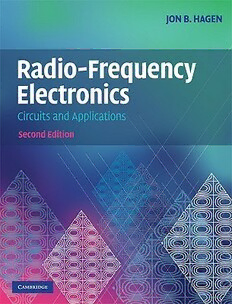Table Of ContentRadio-Frequency Electronics
CircuitsandApplications
This second, much updated edition of the best-selling Radio-Frequency
Electronics introduces the basic concepts and key circuits of radio-frequency
systems.Itcoversthefundamentalprinciplesapplyingtoallradiodevices,from
wirelesssingle-chipdatatransceiverstohigh-powerbroadcasttransmitters.
Newtothisedition:
* Extensively revised and expanded throughout, including new chapters on
radar,digitalmodulation,GPSnavigation,andS-parametercircuitanalysis.
* Newworkedexamplesandend-of-chapterproblemsaidandtestunderstand-
ingofthetopicscovered.
* Numerous extra figures provide a visual aid to learning, with over 400
illustrationsthroughoutthebook.
Key topics covered include filters, amplifiers, oscillators, modulators, low-
noise amplifiers, phase lock loops, transformers, waveguides, and antennas.
Assumingnopriorknowledgeofradioelectronics,thisisaperfectintroduction
to the subject. It is an ideal textbook for junior or senior courses in electrical
engineering,aswellasaninvaluablereferenceforprofessionalengineersinthis
area.
Praiseforthefirstedition:
Thisbookiswonderfullyinformative,andrefreshinglydifferentfromtheusual
rehash of standard engineering topics. Hagen has put his unique insights,
gleanedfromalifetimeofengineeringandradioscience,intothisvolumeand
it shows. There’s an insight per page, at least for me, that makes it truly
enjoyable reading, even for those of us who think we know something about
thefield!PaulHorowitz,HarvardUniversity
JonB.HagenwasawardedhisPh.D.fromCornellUniversityin1972,wherehe
wentontogain30years’experienceasanelectronicdesignengineer,aswellas
establishing and teaching a Cornell electrical engineering course on RF elec-
tronics.Nowretired,hehasheldpositionsasPrincipalEngineeratRaytheon,
Electronics Department Head at the Arecibo Observatory in Puerto Rico, and
DirectoroftheNAICSupportLaboratoryatCornell.
Radio-Frequency
Electronics
Circuits and Applications
Second Edition
Jon B. Hagen
CAMBRIDGEUNIVERSITYPRESS
Cambridge, New York, Melbourne, Madrid, Cape Town, Singapore,
São Paulo, Delhi, Dubai, Tokyo
Cambridge University Press
The Edinburgh Building, Cambridge CB2 8RU, UK
Published in the United States of America by Cambridge University Press, New York
www.cambridge.org
Information on this title: www.cambridge.org/9780521889742
© Cambridge University Press 1996, 2009
This publication is in copyright. Subject to statutory exception and to the
provision of relevant collective licensing agreements, no reproduction of any part
may take place without the written permission of Cambridge University Press.
First published in print format 2009
ISBN-13 978-0-511-58012-3 eBook (EBL)
ISBN-13 978-0-521-88974-2 Hardback
Cambridge University Press has no responsibility for the persistence or accuracy
of urls for external or third-party internet websites referred to in this publication,
and does not guarantee that any content on such websites is, or will remain,
accurate or appropriate.
Contents
Preface pagexiii
1 Introduction 1
1.1 RFcircuits 2
1.2 NarrowbandnatureofRFsignals 3
1.3 ACcircuitanalysis–abriefreview 3
1.4 Impedanceandadmittance 4
1.5 Seriesresonance 4
1.6 Parallelresonance 5
1.7 Nonlinearcircuits 5
Problems 5
2 Impedancematching 10
2.1 Transformermatching 11
2.2 L-networks 12
2.3 HigherQ–piandT-networks 14
2.4 LowerQ–thedoubleL-network 15
2.5 Equivalentseriesandparallelcircuits 16
2.6 Lossycomponentsandefficiencyofmatchingnetworks 16
Problems 17
3 Linearpoweramplifiers 19
3.1 Single-loopamplifier 19
3.2 Drivecircuitry:common-collector,common-emitter,
andcommon-base 20
3.3 Shuntamplifiertopology 22
3.4 Dual-polarityamplifiers 22
3.5 Push–pullamplifiers 23
3.6 Efficiencycalculations 25
3.7 ACamplifiers 26
v
vi Contents
3.8 RFamplifiers 29
3.9 Matchingapoweramplifiertoitsload 31
Problems 31
4 Basicfilters 34
4.1 Prototypelowpassfilterdesigns 35
4.2 Alowpassfilterexample 36
4.3 Lowpass-to-bandpassconversion 38
Appendix4.1Componentvaluesfornormalized
lowpassfilters 41
Problems 43
References 45
5 Frequencyconverters 46
5.1 Voltagemultiplierasamixer 46
5.2 Switchingmixers 48
5.3 Asimplenonlineardeviceasamixer 51
Problems 53
6 Amplitudeandfrequencymodulation 54
6.1 Amplitudemodulation 55
6.2 Frequencyandphasemodulation 58
6.3 AMtransmitters 62
6.4 FMtransmitters 65
6.5 Currentbroadcastingpractice 65
Problems 66
7 Radioreceivers 67
7.1 Amplification 67
7.2 Crystalsets 68
7.3 TRFreceivers 68
7.4 Thesuperheterodynereceiver 69
7.5 Noiseblankers 74
7.6 Digitalsignalprocessinginreceivers 75
Problems 75
References 76
8 Suppressed-carrierAMandquadratureAM(QAM) 77
8.1 Double-sidebandsuppressed-carrierAM 77
8.2 Single-sidebandAM 78
8.3 Productdetector 80
8.4 GenerationofSSB 81
vii Contents
8.5 Single-sidebandwithclassC,D,orEamplifiers 83
8.6 QuadratureAM(QAM) 84
Problems 85
References 86
9 Class-C,D,andEPowerRFamplifiers 87
9.1 Theclass-Camplifier 87
9.2 Theclass-DRFamplifier 92
9.3 Theclass-Eamplifier 94
9.4 Whichcircuittouse:class-C,class-D,orclass-E? 99
Problems 100
References 100
10 Transmissionlines 101
10.1 Characteristicimpedance 101
10.2 Wavesandreflectedwavesontransmissionlines 103
10.3 Modificationofanimpedancebyatransmissionline 106
10.4 Transmissionlineattenuation 107
10.5 Impedancespecifiedbyreflectioncoefficient 107
10.6 Transmissionlinesusedtomatchimpedances 111
Appendix10.1.Coaxialcable–Electromagneticanalysis 114
Problems 116
11 Oscillators 120
11.1 Negativefeedback(relaxation)oscillators 120
11.2 Positivefeedbackoscillators 121
11.3 Oscillatordynamics 128
11.4 Frequencystability 128
11.5 Colpittsoscillatortheory 129
Problems 132
12 Phaselockloopsandsynthesizers 134
12.1 Phaselocking 134
12.2 Frequencysynthesizers 144
Problems 150
References 151
13 Coupled-resonatorbandpassfilters 152
13.1 Impedanceinverters 152
13.2 Conversionofseriesresonatorstoparallelresonatorsandviceversa 155
13.3 Workedexample:a1%fractionalbandwidthfilter 156
13.4 Tubularbandpassfilters 158
13.5 EffectsoffiniteQ 160
13.6 Tuningprocedures 161
viii Contents
13.7 Otherfiltertypes 161
Problems 162
References 163
14 Transformersandbaluns 164
14.1 The“idealtransformer” 165
14.2 Transformerequivalentcircuit 166
14.3 Powertransformeroperation 168
14.4 Mechanicalanalogueofaperfectlycoupledtransformer 169
14.5 Magnetizinginductanceusedinatransformer-coupledamplifier 170
14.6 Double-tunedtransformer:makinguseofmagnetizationandleakage
inductances 170
14.7 Lossintransformers 172
14.8 Designofiron-coretransformers 172
14.9 Transmissionlinetransformers 175
14.10 Baluns 176
Problems 178
References 180
15 Hybridcouplers 181
15.1 Directionalcoupling 182
15.2 Transformerhybrid 182
15.3 Quadraturehybrids 185
15.4 Howtoanalyzecircuitscontaininghybrids 186
15.5 Powercombiningandsplitting 187
15.6 Otherhybrids 189
Problems 192
Reference 194
16 Waveguidecircuits 195
16.1 Simplepictureofwaveguidepropagation 195
16.2 Exactsolution:aplanewaveinterferencepatternmatches
thewaveguideboundaryconditions 196
16.3 Waveguidevs.coaxforlow-losspowertransmission 201
16.4 Waveguideimpedance 201
16.5 Matchinginwaveguidecircuits 202
16.6 Three-portwaveguidejunctions 202
16.7 Four-portwaveguidejunctions 203
Appendix16.1Lowestlosswaveguidevs.lowestlosscoaxialline 204
Appendix16.2Coaxdimensionsforlowestloss,highestpower,
andhighestvoltage 206
Problems 207
References 207
ix Contents
17 Small-signalRFamplifiers 208
17.1 Lineartwo-portnetworks 208
17.2 Amplifierspecifications–gain,bandwidth,
andimpedances 210
17.3 Narrowbandamplifiercircuits 213
17.4 Widebandamplifiercircuits 214
17.5 Transistorequivalentcircuits 214
17.6 Amplifierdesignexamples 215
17.7 Amplifiernoise 219
17.8 Noisefigure 220
17.9 Othernoiseparameters 222
17.10 Noisefiguremeasurement 223
Problems 223
References 226
18 Demodulatorsanddetectors 227
18.1 AMDetectors 227
18.2 FMdemodulators 233
18.3 Powerdetectors 238
Problems 240
References 241
19 Televisionsystems 242
19.1 TheNipkovsystem 242
19.2 TheNTSCsystem 243
19.3 Digitaltelevision 251
Problems 257
References 258
20 Antennasandradiowavepropagation 259
20.1 Electromagneticwaves 259
20.2 Radiationfromacurrentelement 261
20.3 Dipoleantenna 262
20.4 Antennadirectivityandgain 264
20.5 Effectivecaptureareaofanantenna 266
20.6 Reflectorandhornantennas 267
20.7 Polarization 271
20.8 Aspacecraftradiolink 272
20.9 Terrestrialradiolinks 273
20.10 Theionosphere 273
20.11 Othermodesofpropagation 275
Problems 276
References 277
x Contents
21 Radar 278
21.1 Somerepresentativeradarsystems 278
21.2 Radarclassification 281
21.3 Targetcharacteristicsandechostrengths 283
21.4 Pulsecompression 285
21.5 Syntheticapertureradar 286
21.6 TRswitches 288
21.7 Diodeswitches 291
21.8 Radarpulsemodulators 293
Problems 297
References 298
22 Digitalmodulationtechniques 300
22.1 Digitalmodulators 300
22.2 Pulseshaping 303
22.3 Rootraised-cosinefilter 307
22.4 8-VSBandGMSKmodulation 308
22.5 Demodulation 309
22.6 Orthogonalfrequency-divisionmultiplexing–OFDM 310
22.7 Spread-spectrumandCDMA 315
Problems 318
Glossary 318
References 320
23 Modulation,noise,andinformation 321
23.1 Matchedfiltering 321
23.2 AnalysisofaBPSKlink 323
23.3 On–offkeyingwithenvelopedetection 325
Problems 335
References 335
24 Amplifierandoscillatornoiseanalysis 336
24.1 Amplifiernoiseanalysis 336
24.2 Oscillatornoise 342
24.3 Effectofnonlinearity 346
Problems 346
References 348
25 TheGPSNavigationsystem 349
25.1 Systemdescription 349
25.2 GPSbroadcastformatandtimeencoding 350
25.3 GPSsatellitetransmitter 352
25.4 Signaltracking 353

